Updated for Logos 34+
Page Contents
- The Visual Filter Menu is found on the toolbar of most books.

- do not confuse this with Visual Filters which are created from the Documents menu.
- It allows you to control what is visually shown in a book.
- The contents of this menu may differ depending on the book, the dataset features and the documents that you have.
- The filters that are shown in the Visual filters menu include Book reformatting, Word emphasis, Markers, Notes and Highlights, Media, Passage Lists, and Reading Plans.
- When a group (or filter) header is checked, it will activate subordinate items that are also checked.
When it is unchecked it will render subordinate items inactive, without changing their state.
- When a subordinate item is checked it can be activated and when it is unchecked it cannot be activated.
- Right click a menu item to turn ON/OFF that item in all books.
- Show in all appropriate books will turn it ON in all books.
- Do not show in any books: will turn it OFF in all books.
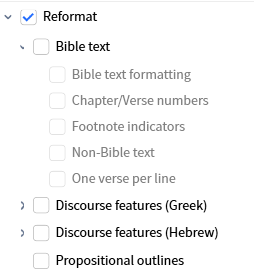
Bible text
- When unchecked your Bible book is shown normally.
- When checked with the sub-items all unchecked, your Bible book is shown without formatting, chapter/verse numbers, pericopes, and footnote indicators in a verse-by-verse display.
- check the sub-items to see the effect on the display.
Discourse features (Greek)
- When Checked Logos will display Discourse Analysis features in the text of your (Greek) original language or reverse-interlinear Bible. On hover the graphical markers will show a popup describing the feature.
- For more information see Discourse Visual Filters
Discourse features (Hebrew)
- When Checked Logos will display Discourse Analysis features in the text of your (Hebrew) original language or reverse-interlinear Bible. On hover the graphical markers will show a popup describing the feature.
- For more information see Discourse Visual Filters
Propositional outlines (NT and OT)
- This visual filter shows the functional features of each clause in a bible, and it presents a translation through a diagram that helps readers visualize the flow of thought within the text. It can be applied to any Bible with a reverse interlinear, or to an original language bible:
- it has a graphical layout that tells you how clauses relate to one another
- Breaks the text down into “preachable” sections
- Shows the flow of thought
- Shows the function of each clause
- The Outline Formatting visual filter reformats selected lexicons to be easier to read and understand. Definitions and sub-definitions are broken into separate paragraphs, and long compound sentences are broken into separate bullet items.
Markers
Addressee labels
- When checked this enables the addressees in reported speech to be marked in the text of your bible.
There can be multiple addressees for a section of reported speech.
Speaker labels
- When checked this enables the speakers in reported speech to be marked in the text of your bible.
Page numbers
- When checked page numbers will be shown at relevant places in the text. A volume number will be included where appropriate.
Timeline events
- When checked markers (hollow flags) are displayed at locations in the text that have a date associated with an event. The event marker (a solid flag) is a link to the Timeline tool.
Corresponding text in other books
Search results
- When checked Search results from a corresponding original language or reverse-interlinear book will be displayed.
- It is the same as running that Search on your book.
Text selection
(Corresponding Selection)
- When checked this enables a selection in one book to highlight corresponding words in another that also has this filter checked.
It works only between original language or reverse-interlinear books (not restricted to bibles).
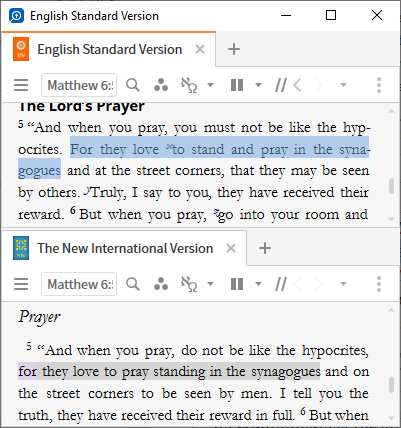
Emphasize
Corresponding words
- When Checked Logos will automatically highlight words that correspond to the one you have clicked/hovered over.
- Sub-menu items shown will depend on the book but include:
- “Same surface text” = same surface text (Greek/Hebrew or English word) in one or more books.
- “Same word” = same Greek/Hebrew manuscript word in the same location (e.g. verse) across multiple books
- “Same lemma” = same Greek/Hebrew lemma in one or more books
- “Same root” = same Greek/Hebrew root in one or more books
- Here is an example using a Hebrew bible and a Reverse Interlinear (RI):
- Both bibles are on Link set A to align the passages displayed
- The Hebrew bible (LHB) has “Same word” checked
- The Reverse Interlinear (ESV) has “Same word” and “Same lemma” checked
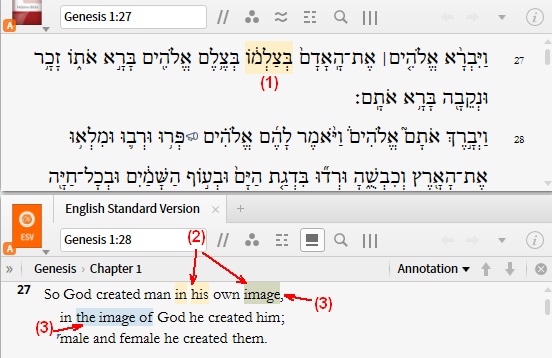
- Click a word (in image his) in the Hebrew bible
- This is the “Same word” in the ESV
- “own” is not aligned with the Hebrew word
- “in the image of” comes from the adjacent Hebrew word
- This is the “Same lemma” in the ESV
- it highlights the words aligned with Hebrew “image”
Current lexicon entry (lemma)
(Emphasize active lemmas)
- When checked Logos will automatically highlight/project the word you’re studying in the Bible Word Study tool, or your lexicon, into your original language or reverse-interlinear book.
- Here is an example:
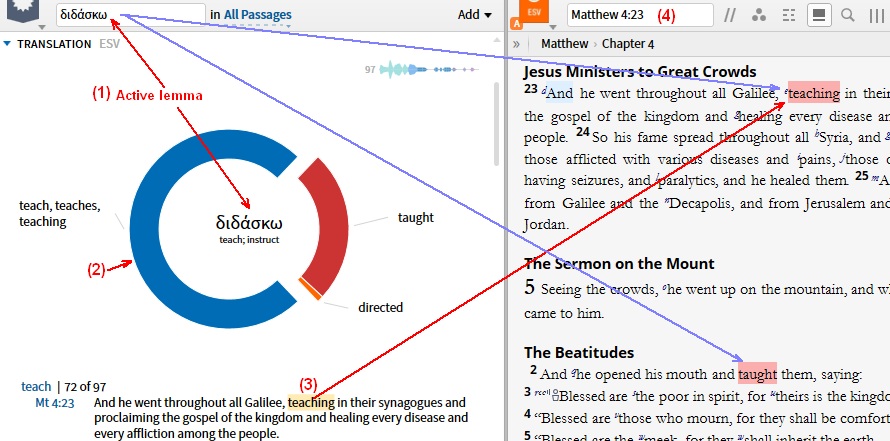
- Open a Bible Word Study to a Greek word, which becomes the Active lemma
- Click the Translation ring for teach, teaches, teaching
- Click on teaching (Mt 4:23),
which - Opens my preferred bible and emphasizes the active lemma in two passages.
Current references
(Emphasize active references)
- When enabled the active reference from another book will be highlighted, if present.

- In the image above, the DBL Greek lexicon is checked for Current references.
- The Bible provides the active reference and Logos highlights references in the lexicon that are the same (or that contain it).
Popular highlights
Only shown where crowd-sourced popular highlights are present.
They can be switched off in all resources if necessary.
Other Filters
- When checked markers for Verse of the Day, Atlas maps, and “other media” will be shown. When clicked the information is displayed in the Media tool.
Notes and Highlights
- This visual filter will appear for books which have Notes and/or Highlighting.
- The menu items in this filter are Notebook names:
- Some may come from started/completed Workflows.
- When checked your Notes and Highlights that are tied to this book will be visible.
- When unchecked your Notes and Highlights will not be visible.
Notes and Highlights (Corresponding)
- When checked you can see the Notes and Highlights that you’ve attached to other biblical texts.
(it works between original language bibles and translations with reverse interlinears).
- For more, see Notes and Highlights above.
Passage Lists
- When checked you can filter your bible/commentary with Passage List(s). It will display only the verse milestones contained in the List.
Reading Plans
- This filter will appear for a book to which you have added a Reading Plan.

- When checked the Start Reading message will be shown in your book (below).

- For information on Reading plans see Reading Plan (Basics)
Visual Filters
- This filter will appear for Visual Filters (created by Visual Filter on the Documents menu) that specify this book or its type.
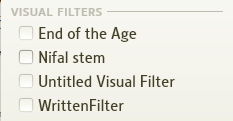
- The menu items in this filter are the document name of the Visual Filter.
- When checked your Visual Filter highlighting will be visible.
- When unchecked your Visual Filter highlighting will not be shown.
- See the wiki page Visual Filter to learn how to make Visual Filters.